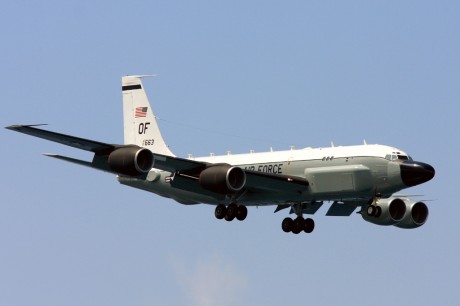How the U.S. Navy and Air Force will Watch North Korea’s Next Missile Launch April 6, 2013
Posted by Michael Glynn in : Military Aviation, North Korea , trackback As tensions continue to rise on the Korean Peninsula, the U.S. Navy and Air Force are ready to watch upcoming missile launches. The two services use a variety of ground based, sea-going, and aerial assets to gather intelligence on foreign missile tests.For decades, the U.S. Air Force has relied on its small group of RC-135S missile tracking aircraft, code-named COBRA BALL. These aircraft are based at Offutt Air Force Base, outside Omaha, Neb. and are flown by the 45th Reconnaissance Squadron.
COBRA BALL is used to track ballistic missiles reentry vehicles and warheads during the final phase of flight.
The aircraft has a powerful radar array on the starboard side of the fuselage, just aft of the cockpit. Several optical quality windows are mounted on the starboard side as well, allowing infrared and visible spectrum cameras to record the warheads during their final moments of flight.
Take special note of the black low-glare paint used on the starboard wing, to improve image quality and prevent glare during photography.

Image credit: ブニョ氏のブログ
RC-135S crews are augmented by several ground based, phased-array radar systems.
The COBRA DANE radar at Eareckson Air Station in Shemya Alaska is used to provide radar coverage over the Northern Pacific. While the system is accurate enough to track small objects in space, its utility depends on the direction, or azimuth, of the missile launch. The last test of a North Korean missile featured a southern trajectory, launching south over the East China Sea.
In the past few days, Korean media outlets reported the movement of Musudan IRBM launchers and vehicles to Eastern portions of North Korea.
These missiles, if launched on a test flight, would likely be launched in an easterly direction, overflying Japan and landing in the Philippine Sea.
To provide additional coverage, the U.S. Navy is able to use its missile tracking ship, the USNS Observation Island (T-AGM-23). The Observation Island features the legacy COBRA JUDY phased array radar system. The ability to position in advance of a launch provides excellent flexibility to place Observation Island in the idea position to gather high quality radar intelligence and telemetry data.
Observation Island is schedule to be replaced in the near future by USNS Howard O. Lorenzen (T-AGM-25). However, Lorenzen experienced significant difficulties during acceptance trials, and has not yet become operational. The new ship will be equipped with an upgraded variant of the legacy radar, code-named COBRA KING.
No comments:
Post a Comment